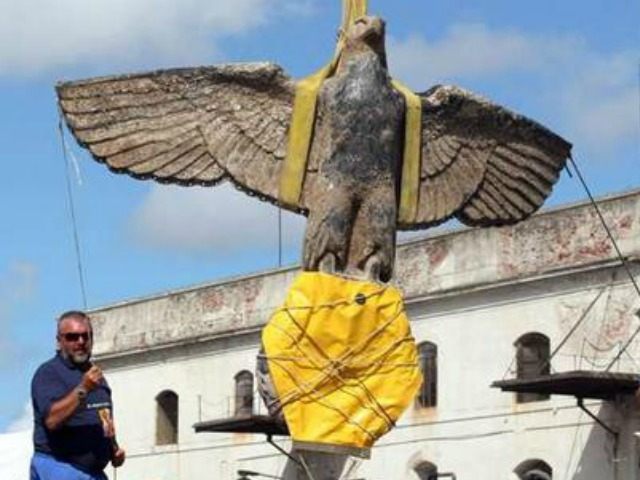In December of 1939 the German pocket battleship Admiral Graf Spee fought a relentless battle with an allied task force off the coast of Uruguay. Badly damaged after a ferocious fight, the Admiral Graf Spee was pulled into a Uruguay harbor and scuttled. Seventy-five years later, pieces of the wreckage are in the hands of the Uruguay government and salvagers, prompting a debate about what to do with the Nazi artifacts.
A debate over what to do with the four-ton bronze eagle that had been displayed on the Graf Spee has been particularly fierce, according to BBC, as the artifact is potentially worth millions of dollars. Some fear that the sale could attract pro-Nazi sympathizers.
The Graf Spee wreaked havoc in the South Atlantic in the early days of World War II as it was tasked with sinking Allied merchant ships. The chaos caused by the Graf Spee prompted the British Navy to seek and destroy what was then one of the most modern and powerful heavy cruisers in the world. Three British cruisers were dispatched to sink the Graf Spee, and they finally got their chance on December 13, 1939. The River Plate Battle, as it came to be named, was the war’s first major confrontation between the British and German navies.
In what Winston Churchill called a “brilliant sea fight” that “warmed the cockles of the British heart,” the British cruisers badly damaged and defeated the Admiral Graf Spee in just over an hour of ferocious combat. The disabled Graf Spee limped into a Montevideo, Uruguay harbor, completely unable to continue the fight. Though the Graf Spee’s captain, Hans Langsdorff, pleaded with local authorities to allow him to fix and resupply his ship, the request was denied.
Knowing that his ship and crew were doomed in any further confrontation with the British Navy, Captain Langsdorff scuttled the Graf Spee and committed suicide a few days later. It was a tremendous triumph for the British Navy and brought considerable anger and embarrassment to Adolf Hitler and the German high command.
The wreckage of the Graf Spee has brought attention from salvagers and fortune seekers. In 2006, a giant bronze eagle standing on a Nazi swastika was dredged up by a salvage team employed by businessman Alfredo Etchegaray.
Etchegaray told BBC that the bronze eagle could be worth $15 million, however, the Uruguayan Supreme Court has ruled that the state is the rightful owner and entitled to half the profits from any potential sale. He believes that the government should make a replica of the piece and allow him to sell the original.
“This way we would be compensated for our work and Uruguay would be able to spend its part on education, technology or better equipment for the navy. But having the eagle in a box doesn’t benefit anybody,” Etchegaray said, according to BBC.
However, some are concerned that artifacts like the bronze eagle could find their way into the hands of Nazi sympathizers. In the aftermath of World War II, many Nazis fled to South America to escape war crime trials and other retribution from the Allies. Though Uruguay and many other South American countries remained neutral in the conflict, they did not escape being embroiled in the battles and political repercussions of the war.
In a visit to Uruguay in 2010, German foreign minister Guido Westerwelle expressed concerns about the Nazi artifacts. He said, “We want the remains of the Graf Spee to be dealt with properly,” and continued, according to BBC, “We want to prevent wreckage from the ship, in particular the Nazi symbols, from landing on the market for military insignia.” While many Uruguayans argue that the Nazi relics could bring a windfall of profits to the country, any future sale will be seen as controversial.
Despite the concerns about the Nazi artifacts, there have been recent attempts to memorialize the British and German sailors who died in the fierce fighting, 75 years ago. On the day of the anniversary, the National Memorial Arboretum in Alrewas, England made a tribute to the remaining survivors and created a 6 ft. monument so that future generations will know about the sacrifices made in the battle. According to the Daily Mail, the memorial is engraved with crests of the three British cruisers that took part in the fighting and includes the words, “It is dedicated to those who served in the ships at the battle and in subsequent action especially those who gave their lives.”

COMMENTS
Please let us know if you're having issues with commenting.